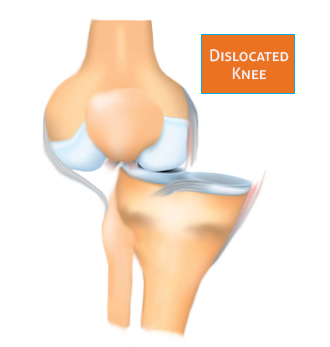What is a Dislocated Knee?
A dislocated knee occurs when the position of the thighbone gets disrupted relative to that of the tibia and the fibula. Then, the ligaments holding the bones of the knee tear. Thus causing the bones to move out of place.
Ligaments are responsible for stabilizing the position of the knee and holding the bones together. A dislocated knee occurs as a result of trauma to the leg caused by a car accident, sports injuries, or falls. However, a knee dislocation is different from a dislocated kneecap.
A dislocated kneecap occurs when the kneecap slips out of place. It can happen when there is a sudden change in direction or blow. Typically it occurs when the foot is ground firmly on a surface. Moreover, a dislocated knee is a pretty rare injury compared to a dislocated kneecap. But it is critical because it can damage several blood vessels, nerves, and ligaments.
What Causes a Dislocated Knee?
When a knee dislocation occurs, it is typically the result of:
- Car accidents: If the knee hits against a hard surface like a dashboard, the force of the impact can disrupt the knee.
- Hard falls: It is common among runners and skiers who lose control and fall on over-extended or bent knees.
- Sports injuries: The player may collide with another player. Then, hit the ground with a bent knee or over-extended his knee causing a dislocation.
Knee Dislocation Symptoms
The symptoms are evident immediately and worsen over time. The most common include:
- A popping sound at the time of the injury
- A visible deformity at the joint
- Swelling
- Severe pain in the knee
- Limited range of movement of the knee
How is a Dislocated Knee Diagnosed?
The doctor begins by repositioning the injured limb. This allows for reduced pressure on the blood vessels, nerves, and on the skin of the affected area. He then assesses the extent of the injury to determine the range of movement and degree of stability of specific parts of the knee.
Further examination of a knee dislocation involves:
- Checking the dorsal pedal and posterior tibial pulses. A low pulse indicates an injury to the blood vessel
- Checking the blood pressure of the leg. Low blood pressure means poor blood flow to the lower extremities
- Identifying any changes in the color of the leg
- Testing for nerve conduction to determine the function of the nerves in the knees and legs
Treatment for a Knee Dislocation
The first step in treating a dislocated knee involves restoring its original position. Next, the doctor administers a sedative to minimize pain during the procedure.
The doctor may perform surgery to repair damaged nerves, blood vessels, and ligaments. However, conservative treatment is ideal when:
- The joint looks stable after the reduction procedure
- There is no evidence of damaged blood vessels or nerves
- The collateral knee ligaments remain intact
Recovering from a Dislocated Knee
The patient needs to wear braces to aid in recuperation. Next, the doctor will send the patient to a physical therapist who helps perform exercises that strengthen the leg muscles. As such, the recovery period may extend to a year, and athletes resuming sports activities may not be able to perform at the same level.
If you are experiencing a dislocated knee, call us today at 888-409-8006 to visit a knee specialist. Offices conveniently located in South Florida; Boca Raton, Deerfield Beach & Plantation.
OUR DOCTORS
[/vc_column_text]
Knee Specialists
Our teams of qualified and skilled physicians provide a personalized experience in a caring and comfortable environment to enhance the quality of life of our patients. Utilizing the latest medical technologies and treatments, our staff are committed to delivering convenient and valuable services to meet the needs of the community.
